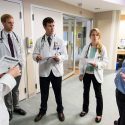Building a new cadre of science faculty, center makes next big leap
The national experiment to develop a new generation of college science and engineering faculty, one equipped to excel in the classroom as well as the lab, is about to shift into high gear.
Since 2003, the Center for the Integration of Research, Teaching and Learning (CIRTL) has blazed a new trail for preparing science graduate students at a handful of top universities to be as bold and creative in the classroom as they are in their programs of research. That effort, it was announced today (Oct. 10), will be expanded to include 25 of the nation’s top universities in the CIRTL Network.
“For the last four years, we’ve had six universities in the prototype network,” says Robert Mathieu, a University of Wisconsin–Madison professor of astronomy and a co-founder of the center. “This is a jump to wide national impact.”
Supported by the National Science Foundation (NSF), and headquartered at UW–Madison, CIRTL’s mission is to develop a national faculty in science, technology, engineering and mathematics that transcends a graduate student model that now does relatively little to prepare students for their future classroom responsibilities. In addition, CIRTL focuses on the challenges and opportunities posed by the increasing diversity of science and higher education.
The inadequate preparation of science graduate students to assume their teaching roles is a long-recognized problem of national importance. While graduate students compose the future cadre of college-level science instructors, their preparation for the classroom typically consists of little more than a semester or two working as teaching assistants, often with little mentoring.
CIRTL, Mathieu explains, provides a new philosophical and strategic springboard for individual campuses to develop programs aimed at giving graduate students in the sciences, engineering and math the skills and tools to be creative and rigorous in the classroom.
A foundational CIRTL concept is that improving one’s teaching boils down to the key question “What have my students learned?” This question, Mathieu argues, can be addressed in each classroom by the experimental method familiar to scientists: hypothesis generation, experiment, observation, analysis and improvement. This approach is called “teaching-as-research,” Mathieu explains.
At UW–Madison, a prototype CIRTL learning community, the Delta Program in Research Teaching and Learning, has been established to provide a menu of experiences and resources for graduate students and faculty. Each semester, more than 100 future faculty take graduate classes that develop skills in teaching-as-research in many contexts. The idea, says Mathieu, is to imbue that philosophy into classroom teaching, teaching with technology, laboratory programs, informal education, undergraduate research mentoring, and more. In addition, teaching-as-research internships are built into the program to put formal instruction into practice and to improve undergraduate education at UW–Madison as well.
The addition of 19 new universities to the CIRTL Network marks a critical junction in the effort to improve the way science and math are taught on all of the nation’s college campuses.
“What unites the CIRTL Network universities is a commitment to developing a national STEM faculty better prepared to teach,” according to Mathieu, “through three core ideas: teaching-as-research, learning communities and learning-through-diversity.”
Diversity can be a challenge and opportunity for college-level science teachers. As graduate students become faculty, they will increasingly encounter students from diverse racial, ethnic, national and educational backgrounds, and whose learning experiences may vary from the traditional. CIRTL seeks to create a college faculty able to use this diversity to enhance the learning of all. What’s more, there are many kinds of college-level learning environments ranging from large public research and urban universities to small liberal arts colleges and private institutions.
“The diversity of the new expanded CIRTL Network will enhance the graduate student’s preparation for the landscape of higher education today,” says Mathieu. “They will learn from an array of students and faculty from different kinds of institutions.”
The growth of the CIRTL network, Mathieu avers, will give the program a much larger national footprint and the ability to influence many more of the nation’s future science faculty. “Of course, the beauty of the teaching-as-research idea,” he says, “is that ultimately the teaching-through-research of these faculty themselves will establish the enhanced learning of their students.”


